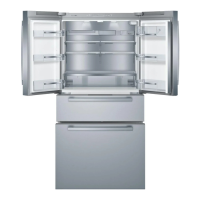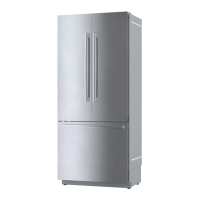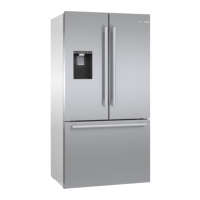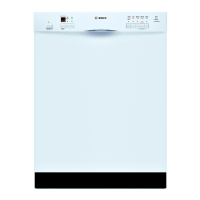
Do you have a question about the Bosch B36IT905NP and is the answer not in the manual?
| Brand | Bosch |
|---|---|
| Model | B36IT905NP |
| Category | Refrigerator |
| Type | French Door |
| Total Capacity | 21.5 cu. ft. |
| Ice Maker | Yes |
| Water Dispenser | Yes |
| Energy Star Certified | Yes |
| Color | Stainless Steel |
Explains how to read and use the manual, including definitions of terms and symbols.
Advises on safe usage by children and individuals with reduced capabilities, requiring supervision.
Warns about sealing ventilation and storing flammable materials, citing explosion risks.
Details safety measures during installation, servicing, and cleaning to prevent electric shock.
Advises against prolonged skin contact with frozen items or surfaces inside the freezer.
Warns about the potential for carbonated drink containers to burst in the freezer.
Explains the flammability of refrigerant and actions to take if the refrigeration circuit is damaged.
Cautions against using multi-outlet power strips or portable power supplies to prevent fires.
Emphasizes keeping keys away from children and preventing access to packaging.
Provides guidance on avoiding appliance damage, such as protecting door seals and avoiding leaning.
Highlights the appliance's heavy weight and the need for two-person handling during setup.
Informs users about potential chemical content related to California's Proposition 65 warning.
Defines the appliance's purpose for cooling, freezing, and ice making in a domestic setting.
Covers responsible disposal of packaging and old appliances, promoting recycling.
Lists items included in the delivery and advises checking for transport damage upon receipt.
Mentions that technical specifications are found on the appliance's rating plate.
Details critical installation aspects like location, cut-out dimensions, and structural support.
Refers to specific instructions for installing the appliance alongside another unit.
Provides advice on appliance placement and ventilation to minimize energy consumption.
Offers tips on door usage, food placement, and ventilation for reduced energy use.
Steps for initial cleaning and preparation before first use.
Details the requirements and precautions for connecting to a potable water supply.
Outlines the acceptable range for water pressure to ensure proper appliance function.
Explains safe electrical connection procedures, including grounding and outlet requirements.
Identifies major sections and components of the 2-door refrigerator-freezer.
Details the various shelves, containers, and controls within the refrigerator section.
Details the various containers and features within the freezer section.
Identifies the main operating controls and their functions.
Identifies major sections and components specific to the 3-door refrigerator-freezer.
Details the shelves, containers, and controls within the refrigerator section of a 3-door model.
Details the containers and features within the freezer section of a 3-door model.
Identifies the door pillar with condensation protection on 3-door appliances.
Explains the use of the menu, settings, and temperature display buttons.
Guides on activating energy-saving, vacation, and Sabbath modes.
Details how to adjust language, Home Connect, display, and units settings.
Explains ice production, water filter counter reset, self-test, and demo mode.
Instructions for removing and repositioning storage compartments.
Guides on how to take out and put back storage bins or containers.
Procedures for removing shelves and ensuring they are correctly leveled upon re-insertion.
Information on using the ice pack for temporary cooling during power outages.
Explains the ice production process, automatic stopping, and hygiene considerations.
Step-by-step guide for changing the water filter or bypass cartridge and resetting the counter.
Steps to switch on the appliance and set the initial operating temperatures.
Practical advice for optimal appliance performance and cooling efficiency.
Instructions for safely switching off and disconnecting the appliance from the power supply.
Recommended temperatures for compartments and how to adjust them.
Explains how to activate and use the Super Cooling function for rapid cooling.
Details on how to use Super Freezing for rapid and deep freezing of food.
Explains Eco Mode for energy efficiency and its automatic temperature settings.
How to enable Vacation Mode for energy savings during extended absences.
Describes Sabbath Mode for disabling non-essential functions, respecting religious observance.
Instructions for switching the ice maker on or off, with cautions.
Guidance on activating or deactivating condensation protection for 3-door models.
Introduces the capability to control the appliance remotely via a mobile device.
Notes and initial steps for configuring the Home Connect feature on the appliance.
Basic steps for establishing a wireless network connection for the appliance.
Instructions for pairing the appliance with the Home Connect mobile application.
Explains how to install software updates for the Home Connect feature.
Details how customer service can access appliance data for remote diagnosis.
Procedure for resetting Home Connect settings to default for re-connection.
Instructions for enabling or disabling the appliance's Wi-Fi connection.
Information on data transmitted to the Home Connect server during initial registration.
Explains the door alarm that alerts users if the appliance door is left open.
How to mute the door alarm by closing the door or acknowledging the alert.
Describes the temperature alarm that activates if the freezer compartment exceeds a safe temperature.
Steps to confirm and clear the temperature alarm after resolving the issue.
Guidance on suitable foods, temperature settings, and storage practices for the refrigerator.
Tips for proper food storage, packaging, and avoiding back panel contact.
Explanation of different temperature zones within the refrigerator compartment.
Details on using and adjusting the vegetable container's humidity controller for optimal freshness.
Information on the ideal use of the chill compartment for specific food types like meat and fish.
Outlines the primary uses of the freezer: storing, freezing, and ice making.
Tips for efficiently organizing and utilizing the freezer's volume.
Advice for consumers when buying frozen food, focusing on packaging and cold chain integrity.
Recommendations for loading food to ensure quick freezing and proper air circulation.
Instructions and suitability of various foods for freezing, including preparation methods.
Guidance on selecting and using packaging materials for effective food freezing.
Lists types of packaging that should not be used for freezing food items.
Provides estimated storage durations for different foods when kept frozen.
Explains various methods for thawing food while preserving its quality and safety.
Clarifies that the NoFrost system eliminates the need for manual defrosting of the freezer.
Warns against using abrasive cleaners and advises on proper cleaning tools.
Instructions for safely cleaning the electronic display panel.
Step-by-step guide for cleaning the refrigerator and freezer interiors.
Guidance on cleaning detachable components of the appliance.
Tips for cleaning stainless steel surfaces to maintain appearance and prevent scratches.
Steps to identify and eliminate unpleasant smells within the appliance.
Detailed instructions for removing the old odor filter and installing a new one.
Information about the maintenance-free LED lighting system in the appliance.
Explanation of typical sounds like droning, bubbling, clicking, and cracking.
Advice on leveling the appliance and securing loose parts to minimize noise.
Solutions for temperature discrepancies, including power cycling and checking settings.
Steps to diagnose and fix issues where the display is not lighting up.
Explains why the refrigeration unit might run more often and how to address it.
Steps to take if the appliance is not cooling, including checking demo mode.
Solutions for common ice maker problems, including power, water supply, and temperature.
Addresses causes for few or deformed ice cubes, such as water pressure and filter blockages.
Guides on fixing water leaks, focusing on secure water connections and hose integrity.
Information on reaching customer service for assistance and repair.
Lists phone numbers for customer service and advice on faults by region.
Instructions on how to run the built-in self-test program for fault diagnosis.












